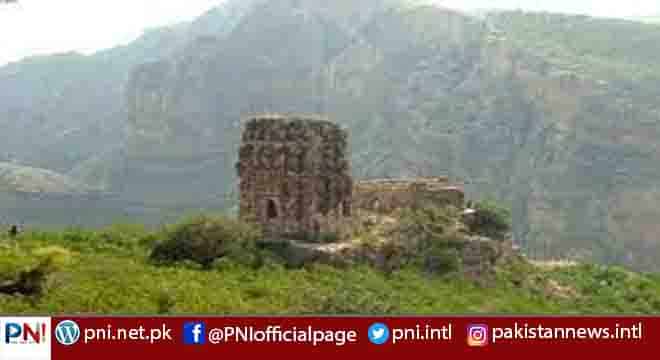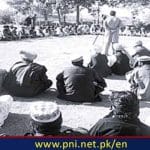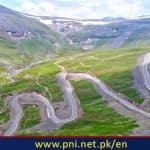By Iftikhar Ahmad
MULTAN, Dec 25 (APP):Al-Bairuni was one of the greatest scientists of all times but very few would know the Muslim science icon had once calculated the radius of earth around a millennium back when he was at the heritage goldmine Nandna fort in Pakistan’s salt range area.
And interestingly, the calculations he came up with using medieval age science techniques had little difference with the modern day figure. It goes without saying the earth radius calculations was only a bit of the numerous scientific achievements attributed to Al-Bairuni, Latinized name Alberonius.
Nandna fort is located in Pind Dadan Khan of district Jhelum, just 6 kilometers south of Khewra Salt Mines, about 24 kilometers east from M2 motorway and 85km from Jhelum.
Sensing its importance, Prime Minister Imran Khan had taken an aerial view of the monument in the last week of Feb 2021 and ordered its immediate conservation, says country’s noted archaeologist Muhammad Hassan who is serving as Deputy Director Archaeology Punjab (South) and leading a team of Archaeology department, well supported by students and teachers of Quaid-e-Azam University, Islamabad, led by chairman department of Archaeology Prof. Dr. M. Hamid, to excavate and conserve the Nandna fort.
George Sarton, the founder of the History of Science discipline, defined Al-Bairuni as “One of the very greatest scientist of Islam, and, all considered, one of the greatest of all times.”
A universal genius that lived in the Central Asia a thousand of years ago, al-Bairuni “was so far ahead of his time that his most brilliant discoveries seemed incomprehensible to most of the scholars of his days,” so wrote Bobojan Gafurov in his article on the Unesco Courier. This quote of noted Tajik author and Acamadician, late Bobojan Gafurov, was mentioned by Italian researcher Amelia Carolina Sparavigna in her research paper “The Science of Al-Biruni” published in international science journal in Dec 2013.
Abu al-Rayhan Muhammad Ibn Ahmad al-Biruni (973-1048), lived in the Central Asia a thousand of years ago. He was born in Kath, Khwarezm, also known as Chorasmia. It’s a large oasis region in Western Central Asia, bordered by Aral Sea and deserts. It was the country of Khwarazmian civilization and of several kingdoms but today it is fractioned and belongs to Uzbekistan, Kazakhstan and Turkmenistan. Al-Bairuni travelled to Persia and Uzbekistan but moved to Ghazni after Mahmud of Ghazni conquered the emirate of Bukhara.
Ghazni which is part of modern Afghanistan was then the capital of Ghaznavid dynasty. Al-Bairuni was an astronomer, mathematician, and philosopher, studying physics and natural science too. He was the first able to obtain a simple formula for measuring the Earth’s radius. He thought possible the Earth to revolve around the sun and developed the idea the geological eras succeed one another.
In fact, Amelia Sparavigna said, in his scientific body of work he addressed almost all the sciences. “When religious fanaticism swept medieval Europe, Al-Bairuni, as a forerunner of the Renaissance, was far in advance of the scientific thought then obtaining in Europe.” Sparavigna said. At Nandna fort, Using trigonometric calculations and his self constructed instrument, Al-Bairuni first measured the height of a hill, north of Nandna fort, by measuring angles subtended by the hill at two points a known distance apart.
Then he climbed the hill to measure the angle of the dip of horizon. “Using an Arabic mile equal to 1.225947 English miles, Al-Bairuni value of radius was equal to 3928.77 English miles, which compares favorably, being different of 2 %, with the mean radius of curvature of the reference ellipsoid at the latitude of the measurement; this mean radius is of 3847.80 miles,” says the research paper of Amelia Sparavigna.
Nandna fort where At-Bairuni did his scientific work, stands atop a steep hill in Salt Range of Punjab’s Pothohar region, as a tourism and heritage goldmine, now all set to emerge as an international level site under Rs 126 million project, envisioned to serve as a gateway to seven major archaeological sites in the region, lead archaeologist Muhammad Hassan said.
Hassan told APP that the Rs 126 million Conservation and Development of Nandna Fort project is meant to preserve two temples and mosque, development of public facilities including approach path, Al-Bairuni Observatory and others.
Work began at the site from May-June 2021, within a few months after Prime Minister’s orders. Initial scientific archaeological investigations revealed a large number of stone structures comprising houses, courtyards, small cells, water reservoir and remnants of fortification wall. Furthermore, a number of potsherds/pottery, a few copper coins of Hindu Shahi and Ghaznavid period, terracotta pottery, stone objects and beads have also been found.
Nandna fort is located at a height of around 1600 feet from the ground with Baghanwala village at its foot. Buildings department has been assigned to develop a pathway that would go up from Baghanwala village to the top like a spiral around the hill and a walk to the fort would be around 1.5-2 kilometer long, the official said.
Hassan said that he along with his team members had to walk up to the site daily adding that they have completed the first phase of archaeological investigations and conservation and would move to the site for second phase in Feb-March 2022. The overall project is expected to complete by June 2022 to pave the way for opening of the tourism site for the public and inspire students with craving for science to do wonders for the country.
Follow the PNI Facebook page for the latest news and updates.








